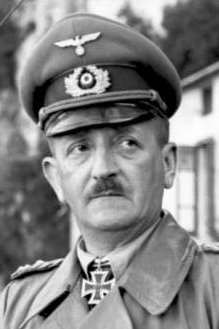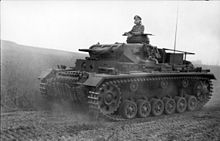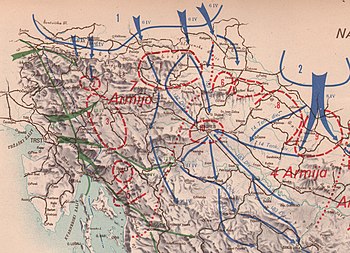
The invasion of Yugoslavia, also known as the April War or Operation 25, was a German-led attack on the Kingdom of Yugoslavia by the Axis powers which began on 6 April 1941 during World War II. The order for the invasion was put forward in "Führer Directive No. 25", which Adolf Hitler issued on 27 March 1941, following a Yugoslav coup d'état that overthrew the pro-Axis government.
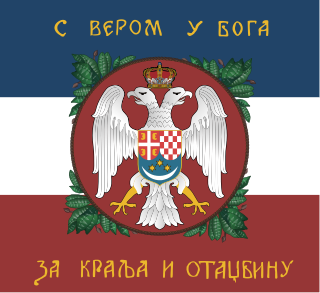
The Yugoslav Army, commonly the Royal Yugoslav Army, was the land warfare military service branch of the Kingdom of Yugoslavia. It existed from the Kingdom's formation in December 1918, until its surrender to the Axis powers on 17 April 1941. Aside from fighting along the Austrian border in 1919 and 1920 related to territorial disputes, and some border skirmishes on its southern borders in the 1920s, the JV was not involved in fighting until April 1941 when it was quickly overcome by the German-led invasion of Yugoslavia.

The Croatian Armed Forces were formed in 1944 with the uniting of the Croatian Home Guard and the Ustaše Militia in the Independent State of Croatia (NDH). It was established by the fascist Ustaše regime of Ante Pavelić in the NDH an Axis puppet state in Yugoslavia during World War II.
The Central Army Group (CENTAG) was a NATO military formation comprising four Army Corps from two NATO member nations comprising troops from Canada, West Germany and the United States. During the Cold War, CENTAG was NATO's forward defence in the southern half of the Federal Republic of Germany (FRG). The northern half of the FRG was defended by the four Army Corps of NATO's Northern Army Group (NORTHAG). During wartime, CENTAG would command four frontline corps. Air support was provided by Fourth Allied Tactical Air Force.
The Gudovac massacre was the mass killing of around 190 Bjelovar Serbs by the Croatian nationalist Ustaše movement on 28 April 1941, during World War II. The massacre occurred shortly after the German-led Axis invasion of Yugoslavia and the establishment of the Ustaše-led Axis puppet state known as the Independent State of Croatia (NDH). It was the first act of mass murder committed by the Ustaše upon coming to power, and presaged a wider Ustaše-perpetrated campaign of genocide against Serbs in the NDH that lasted until the end of the war.
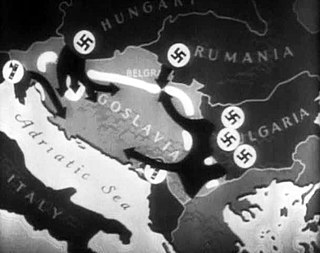
The Yugoslav order of battle before the invasion of Yugoslavia includes a listing of all operational formations of the Royal Yugoslav Army, Royal Yugoslav Army Air Force and Royal Yugoslav Navy immediately prior to the World War II invasion of that country in April 1941.

The Axis order of battle for the invasion of Yugoslavia was made up of the various operational formations of the German Wehrmacht and Waffen-SS, Italian Armed Forces and Hungarian Armed Forces that participated in the invasion of Yugoslavia during World War II, commencing on 6 April 1941. It involved the German 2nd Army, with elements of the 12th Army and a panzer group combined with overwhelming Luftwaffe support. The eighteen German divisions included five panzer divisions, two motorised infantry divisions and two mountain divisions. The German force also included two well-equipped independent motorised regiments and was supported by over 800 aircraft. The Italian 2nd Army and 9th Army committed a total of 22 divisions, and the Royal Italian Air Force had over 650 aircraft available to support the invasion. The Hungarian 3rd Army also participated, with support from the Royal Hungarian Air Force.
The 1st Army Group was a Royal Yugoslav Army formation mobilised prior to the German-led Axis invasion of Yugoslavia in April 1941 during World War II. It consisted of the 4th Army, 7th Army, and the 1st Cavalry Division, which was the army group reserve. It was responsible for the defence of northwestern Yugoslavia, with the 4th Army defending the eastern sector along the Yugoslav–Hungarian border, and the 7th Army defending the western sector along the borders with Germany and Italy. Like all Yugoslav formations at the time, the 1st Army Group had serious deficiencies in both mobility and firepower as well as internal friction among the different ethnic groups, particularly between Serbs and Croats.
The 2nd Army Group was a Royal Yugoslav Army formation commanded by Armijski đeneral Milutin Nedić during the German-led Axis invasion of the Kingdom of Yugoslavia in April 1941 during World War II. It consisted of the 1st and 2nd Armies, comprising four infantry divisions, one horsed cavalry division, two brigade-strength infantry detachments, and one horsed cavalry regiment. It was responsible for the defence of the border with Hungary from Slatina to the Tisza river.

The 2nd Army was a Royal Yugoslav Army formation commanded by Armijski đeneral Dragoslav Miljković that opposed the German-led Axis invasion of the Kingdom of Yugoslavia in April 1941 during World War II. It consisted of three infantry divisions and one horsed cavalry regiment along with supporting units. It formed part of the 2nd Army Group, and was responsible for the defence of the Yugoslav–Hungarian border along the Drava river from Slatina to the Danube.
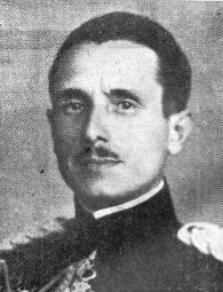
The 5th Army was a Royal Yugoslav Army formation which commanded five divisions and two independent detachments during the German-led Axis invasion of the Kingdom of Yugoslavia in April 1941 during World War II. It was commanded by General Vladimir Cukavac, and was responsible for the Romanian and Bulgarian borders between the Iron Gates and the Greek border.
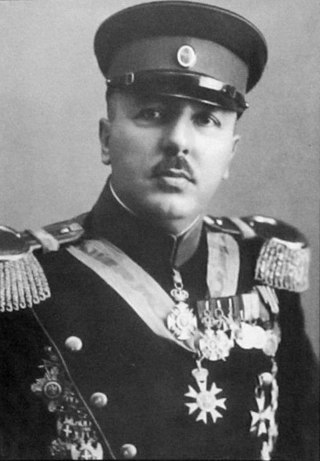
The 7th Army was a Royal Yugoslav Army formation raised prior to the German-led Axis invasion of Yugoslavia in April 1941, during World War II. It consisted of two divisions, two brigade-strength mountain detachments, and a brigade-strength infantry detachment. It formed part of the 1st Army Group, and was responsible for the defence of Yugoslavia's north-western frontier with Italy and Germany. Like all Yugoslav formations at the time, the 7th Army had serious deficiencies in both mobility and firepower.
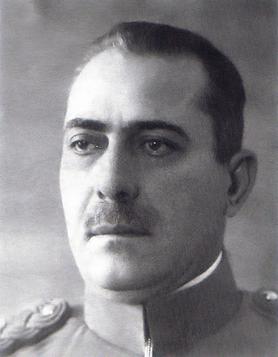
Milorad Petrović was an Armijski đeneral in the Royal Yugoslav Army who commanded the 1st Army Group during the April 1941 German-led Axis invasion of Yugoslavia of World War II. Petrović was commissioned into the Royal Serbian Army in 1901 and served in multiple staff positions during the Balkan Wars. During World War I, he served in various staff roles at the army and divisional level during the Serbian Campaign and later on the Macedonian front. Following the war, he took part in military operations along the disputed northern border of the nascent Kingdom of Serbs, Croats and Slovenes, which was renamed the Kingdom of Yugoslavia in 1929. During the interwar period, Petrović was steadily promoted, performing key roles at the Ministry of the Army and Navy. He reached the rank of armijski đeneral in 1937. At the time of the 27 March 1941 Yugoslav coup d'état, he was the military commander of the Yugoslav capital, Belgrade.
The 42nd Infantry Division Murska was an infantry formation of the Royal Yugoslav Army that formed part of the 4th Army during the German-led Axis invasion of the Kingdom of Yugoslavia in April 1941. It did not have a corresponding divisional district in peacetime, and was raised at the time of mobilisation. Like all Yugoslav infantry divisions of the time, it was a very large and unwieldy formation which was almost entirely reliant on animal transport for mobility, and also lacked modern arms and sufficient ammunition. Commanded by Divizijski đeneral Borisav Ristić, it was largely manned by Croat troops, many of whom saw the Germans as potential liberators from Serbian oppression.
The 40th Infantry Division Slavonska was an infantry formation of the Royal Yugoslav Army that formed part of the 4th Army during the German-led Axis invasion of the Kingdom of Yugoslavia in April 1941. It was partly mobilised from the Osječka military district, and, like all Yugoslav infantry divisions of the time, was a very large and unwieldy formation which was almost entirely reliant on animal transport for mobility. Commanded by Brigadni đeneral Ratko Raketić, it was largely manned by Croat troops, many of whom saw the Germans as potential liberators from Serbian oppression during the interwar period, and the division also lacked modern arms and sufficient ammunition.
The 27th Infantry Division Savska was an infantry formation of the Royal Yugoslav Army that formed part of the 4th Army during the German-led invasion of Yugoslavia by the Axis powers in April 1941. It was raised from the Savska divisional district, and like all Yugoslav infantry divisions of the time, was a very large and unwieldy formation almost entirely reliant on animal transport for mobility. Commanded by Divizijski đeneral August Marić, the division was largely made up of ethnic Croat troops, many of whom saw the Germans as potential liberators from Serbian oppression during the interwar period. It also lacked modern arms and sufficient ammunition.

The 32nd Infantry Division Triglavski was a short-lived Royal Yugoslav Army infantry formation raised prior to the German-led Axis invasion of the Kingdom of Yugoslavia in April 1941. It was largely mobilised from the Dravska military district, and, like all Yugoslav infantry divisions of the time, was a very large and unwieldy formation which was almost entirely reliant on animal transport for mobility. Commanded by Divizijski đeneral Dragiša Pandurović and largely manned by Slovene troops, the division also lacked modern arms and sufficient ammunition.

The 1st Cavalry Division of the Royal Yugoslav Army was established in 1921, soon after the creation of the Kingdom of Serbs, Croats and Slovenes, which became the Kingdom of Yugoslavia in 1929. In peacetime it consisted of two cavalry brigade headquarters commanding a total of four regiments. It was part of the Yugoslav 1st Army Group during the German-led World War II Axis invasion of Yugoslavia in April 1941, with a wartime organisation specifying one cavalry brigade headquarters commanding two or three regiments, and divisional-level combat and support units.
The 38th Infantry Division Dravska was a short-lived Royal Yugoslav Army infantry formation raised prior to the German-led Axis invasion of the Kingdom of Yugoslavia in April 1941. It was largely mobilised from the Dravska divisional district, and, like all Yugoslav infantry divisions of the time, was a very large and unwieldy formation which was almost entirely reliant on animal transport for mobility. Commanded by Divizijski đeneral Čedomir Stanojlović and largely manned by Slovene and ethnic German troops, the division also lacked modern arms and sufficient ammunition to meet the German onslaught.

Predrag Raković was a Yugoslav military officer who joined the Chetnik forces of Draža Mihailović after the Axis invasion of Yugoslavia in April 1941 during World War II. He became commander of the Chetnik 2nd Ravna Gora Corps and collaborated with the German-installed puppet government in the German-occupied territory of Serbia and later directly with the Germans against the rival communist-led Yugoslav Partisans. His forces briefly cooperated with Soviet forces against the Germans in October 1944, but faced with Soviet demands that they lay down their weapons or join the Partisans, they withdrew from occupied Serbia.






